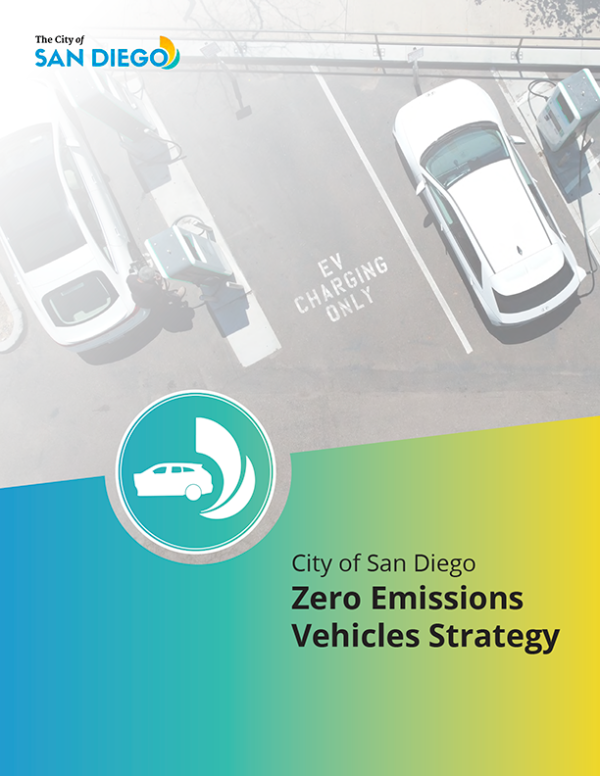Zero Emissions Vehicles Strategy

The City’s 2022 Climate Action Plan sets a target of net zero emissions by 2035. The transportation sector is the largest source of greenhouse gas emissions, and as such, the CAP includes measures to reduce emissions from this sector. CAP Measure 2.3. sets targets that support increasing electric vehicle adoption with a primary action to develop a citywide electric vehicle strategy. The Zero Emissions Vehicles (ZEV) Strategy directly implements Measure 2.3.
The ZEV Strategy serves as a guide for policy needs and opportunities, programs and process improvements, education and engagement, and critical partnerships to ensure equitable access and deployment of clean transportation solutions. It is designed to identify and address the short- and long-term opportunities and barriers to reaching the City’s ZEV goals. The ZEV Strategy identifies areas of action organized into five core strategy pillars that address the varied needs and diversity of our residents, businesses, and visitors. Each core pillar comprises actions designed to function concurrently, ranging from those already underway to those with implementation timelines through the 2035 CAP horizon. It places a premium on developing programs that encourage the integration of all modes into the broader transportation network and identifies actions the City must take to accelerate and accommodate ZEV adoption. Collectively the core strategies and their actions will help the City reach its climate goals.
Download the Zero Emissions Vehicles Strategy
Explore the five core strategy pillars below.
 Strategy Pillar I: Policies
Strategy Pillar I: Policies
 Strategy Pillar I: Policies
Strategy Pillar I: Policies
This strategy supports an equitable transition to zero emissions technologies through local policy and planning.
- Action 1: Update Zoning and Land Use Regulations Related to ZEV Infrastructure
- Action 2: Update Building and Construction Codes for Roadway Infrastructure to Accommodate Current and Future ZEVs
- Action 3: Update Building Codes to Require New Developments and Major Renovations to Include ZEV Charging Infrastructure
- Action 4: Promote the Integration of ZEV Infrastructure in Multimodal Mobility Hubs and TOD
- Action 5: Facilitate the Adoption of Hydrogen Fuel Cell Technology
 Strategy Pillar II: Programs & Processes
Strategy Pillar II: Programs & Processes
 Strategy Pillar II: Programs & Processes
Strategy Pillar II: Programs & Processes
This strategy facilitates infrastructure deployment through streamlined programs and processes.
- Action 1: Streamline Processes for Infrastructure Installation.
- Action 2: Establish Programs to Promote Electric Mobility Across All Modes.
- Action 3: Explore Funding Opportunities that Encourage Local ZEV Deployment and Offset Costs for Residents and Small Businesses.
- Action 4: Lead by Example and Electrify City’s Own Fleet.
 Strategy Pillar III: Community Outreach & Engagement
Strategy Pillar III: Community Outreach & Engagement
 Strategy Pillar III: Community Outreach & Engagement
Strategy Pillar III: Community Outreach & Engagement
This strategy fosters the ZEV transition through direct community outreach, engagement and resources.
- Action 1: Provide Targeted Support to Structurally Excluded and Disadvantaged Communities for ZEV Adoption.
- Action 2: Enhance Community Awareness of the Transition to ZEVs.
- Action 3: Provide Resources to Navigate Charger Permitting and Make Informed Charger Decisions.
- Action 4: Support the Development of Technical Assistance Programs to Prepare Local Businesses, Fleets and Dealerships for ZEV Transition.
 Strategy Pillar IV: Collaboration & Partnerships
Strategy Pillar IV: Collaboration & Partnerships
 Strategy Pillar IV: Collaboration & Partnerships
Strategy Pillar IV: Collaboration & Partnerships
This strategy aims to coordinate local and regional ZEV transition strategies.
- Action 1: Engage in Regional ZEV Collaboration to Optimize Community Interaction and Prioritize Equity.
- Action 2: Collaborate with Regional and State Representatives to Advocate for Legislation and Funding that Fosters Electric Mobility.
- Action 3: Collaborate with Labor, Community Colleges, and Workforce Partners to Support Workforce Development.
- Action 4: Promote Public-Private Partnerships and Explore New Charging Business Models to Meet Local Charging Needs.
- Action 5: Collaborate with Utilities to Provide Resources to Facilitate Informed Charger Decisions.
- Action 6: Collaborate with First and Second Responders on Vehicle and Battery Safety Training.
 Strategy Pillar V: Infrastructure Buildout
Strategy Pillar V: Infrastructure Buildout
 Strategy Pillar V: Infrastructure Buildout
Strategy Pillar V: Infrastructure Buildout
This strategy supports the creation of reliable, accessible and equitable charging infrastructure.
- Action 1: Develop an Equitable ZEV Infrastructure Distribution Framework.
- Action 2: Identify Public Land for ZEV Infrastructure Development.
- Action 3: Explore Opportunities to Improve Grid and Community Resiliency through EV Infrastructure and Advanced Technology Deployment.

